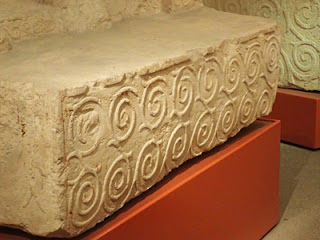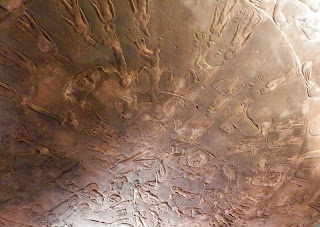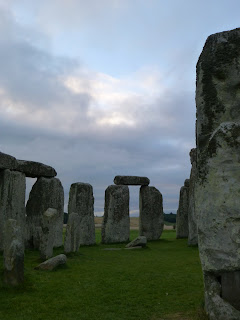Valletta Archaeology Museum
The National Museum of Archaeology, in the midst of Valletta's bustling and busy streets, is a treasure trove of precious artifacts collected from all of the islands' Neolithic temples (from 5000 BC) through to the Phoenician Period (400 BC). The originals have all been moved here, with replicas taking their places in situ.
Housed in the former Auberge de Provence, (Provence being one of the member branches of Knights of St. John), built in 1571, the collection on display ranges from architectural elements of the many Neolithic era temples, to small statuettes of humans and animal figures, to measuring devices, and unique depictions of the divine. Most of the artifacts are from the Temple Period, from approximately 4000 BC to 3200 BC. The devout people of Malta were building temples on a megalithic scale, more than 1000 years before the Egyptian pyramids and 1500 years before Stonehenge.
The temple ornamentation of distinctive interlocking spirals, are reminiscent of waves, fish hooks, and vines. The intention of keeping them in the museum is to spare the priceless designs from degrading, as they are mostly made from a soft limestone, which is susceptible to erosion in the rain and wind.
As it turned out, the museum was as close as I was going to get to the Tarxien site, as it is in the process of being sheltered (similarly to Mnajdra and Hagar Qim) through a project funded by the European Regional Development Fund (ERDF). Tarxien's spiral gates now flank the entrance to the museum. And its magnificent frieze of animals resides here, too.
The demonstrate one of the decorative elements found at the temple sites, called pitting, the deliberate hollowing out of small dots, which, to me, seems to indicate the gathering or concentration of energy. Others interpret the gate's spirals as eyes, and perhaps as ancient warning to keep out.
The deliberate pitting is achieved by carving into the limestone, and appears on many altar surfaces.
This altar is from the inner chambers at Hagar Qim, and depicts a tree or fern growing from a pot a the base. To me, this signifies the tree of life.
Many of the artifacts found that portray humans from the Maltese sites are small, while others are on a gigantic scale. The famous "sleeping lady" from the Hal Saflieni Hypogeum is here at the museum, as well as the "Venus" of Hagar Qim, along with other more gender neutral figures.
Most of the figures depict corpulent body types.
And some were figures that stood guard outside the temple chambers, which were massive in size, carved into the large limestone slabs.
And lest you think that most of the images were female or asexual, there is a cabinet of recovered phallic figures as well.
Many of the interpretations of the Maltese figures center on the notion of fertility being represented in the generously sized bodies. Many of the smaller artifacts have traces of red ochre, indicting use in sacred ritual.
One of the most fascinating artifacts, for me, was the small model of a temple building, complete with its corbelled walls supporting a roof, and trilithon entrance.
While the protection of these priceless artifacts, is of course, of primary concern, it does still disturb me that the originals are in the museum, taken out of their energetic contexts. To me, it feels like an appropriation of power from its creator's source. But, I understand that keeping these cultural treasures where they can be preserved and saved for the future, is a wise decision.
Housed in the former Auberge de Provence, (Provence being one of the member branches of Knights of St. John), built in 1571, the collection on display ranges from architectural elements of the many Neolithic era temples, to small statuettes of humans and animal figures, to measuring devices, and unique depictions of the divine. Most of the artifacts are from the Temple Period, from approximately 4000 BC to 3200 BC. The devout people of Malta were building temples on a megalithic scale, more than 1000 years before the Egyptian pyramids and 1500 years before Stonehenge.
The temple ornamentation of distinctive interlocking spirals, are reminiscent of waves, fish hooks, and vines. The intention of keeping them in the museum is to spare the priceless designs from degrading, as they are mostly made from a soft limestone, which is susceptible to erosion in the rain and wind.
As it turned out, the museum was as close as I was going to get to the Tarxien site, as it is in the process of being sheltered (similarly to Mnajdra and Hagar Qim) through a project funded by the European Regional Development Fund (ERDF). Tarxien's spiral gates now flank the entrance to the museum. And its magnificent frieze of animals resides here, too.
The demonstrate one of the decorative elements found at the temple sites, called pitting, the deliberate hollowing out of small dots, which, to me, seems to indicate the gathering or concentration of energy. Others interpret the gate's spirals as eyes, and perhaps as ancient warning to keep out.
The deliberate pitting is achieved by carving into the limestone, and appears on many altar surfaces.
 |
| Altar from Hagar Qim |
This altar is from the inner chambers at Hagar Qim, and depicts a tree or fern growing from a pot a the base. To me, this signifies the tree of life.
Many of the artifacts found that portray humans from the Maltese sites are small, while others are on a gigantic scale. The famous "sleeping lady" from the Hal Saflieni Hypogeum is here at the museum, as well as the "Venus" of Hagar Qim, along with other more gender neutral figures.
Most of the figures depict corpulent body types.
 |
| Small figurine |
And some were figures that stood guard outside the temple chambers, which were massive in size, carved into the large limestone slabs.
 |
| Temple guardian |
And lest you think that most of the images were female or asexual, there is a cabinet of recovered phallic figures as well.
Many of the interpretations of the Maltese figures center on the notion of fertility being represented in the generously sized bodies. Many of the smaller artifacts have traces of red ochre, indicting use in sacred ritual.
One of the most fascinating artifacts, for me, was the small model of a temple building, complete with its corbelled walls supporting a roof, and trilithon entrance.
While the protection of these priceless artifacts, is of course, of primary concern, it does still disturb me that the originals are in the museum, taken out of their energetic contexts. To me, it feels like an appropriation of power from its creator's source. But, I understand that keeping these cultural treasures where they can be preserved and saved for the future, is a wise decision.













Comments